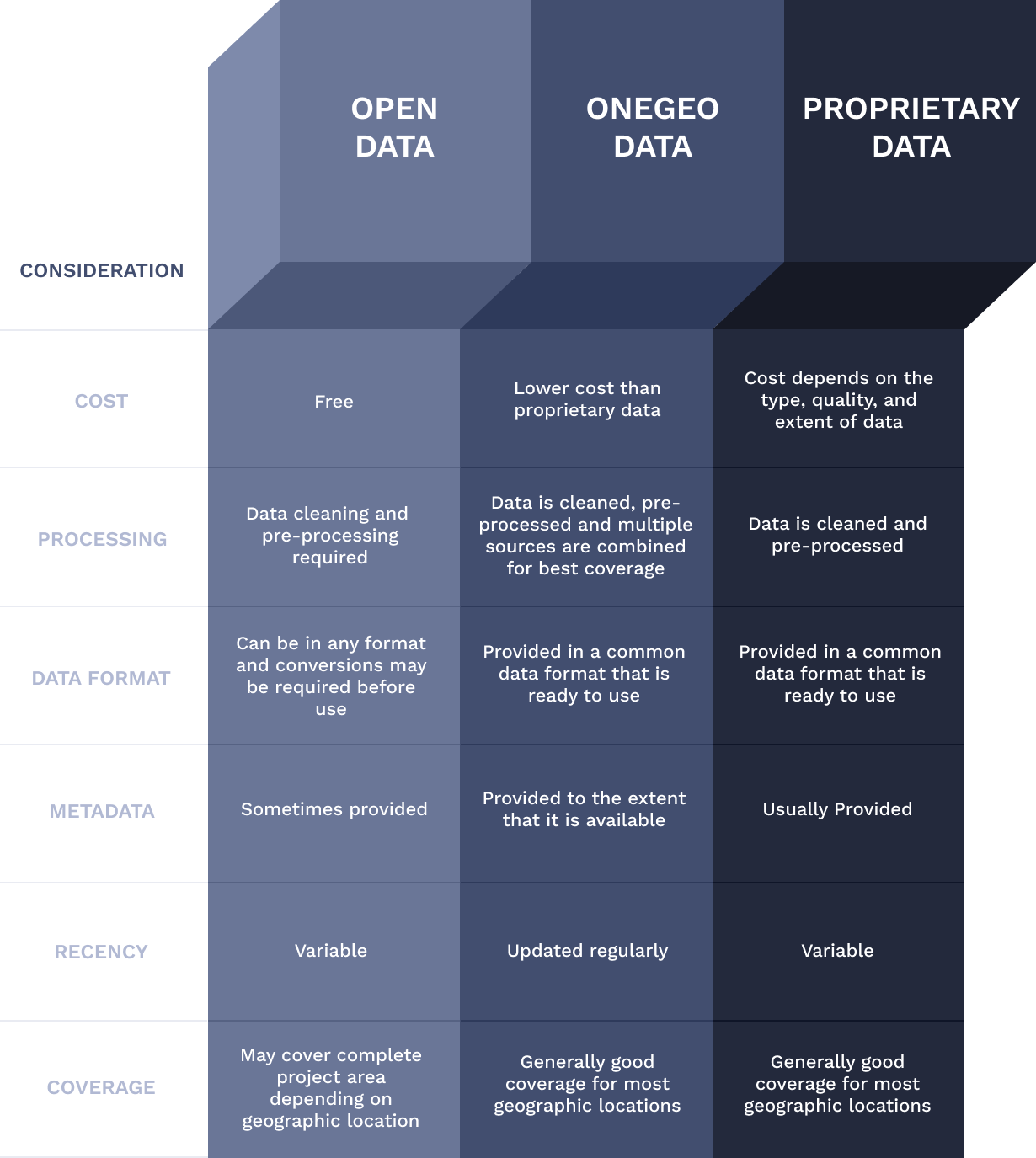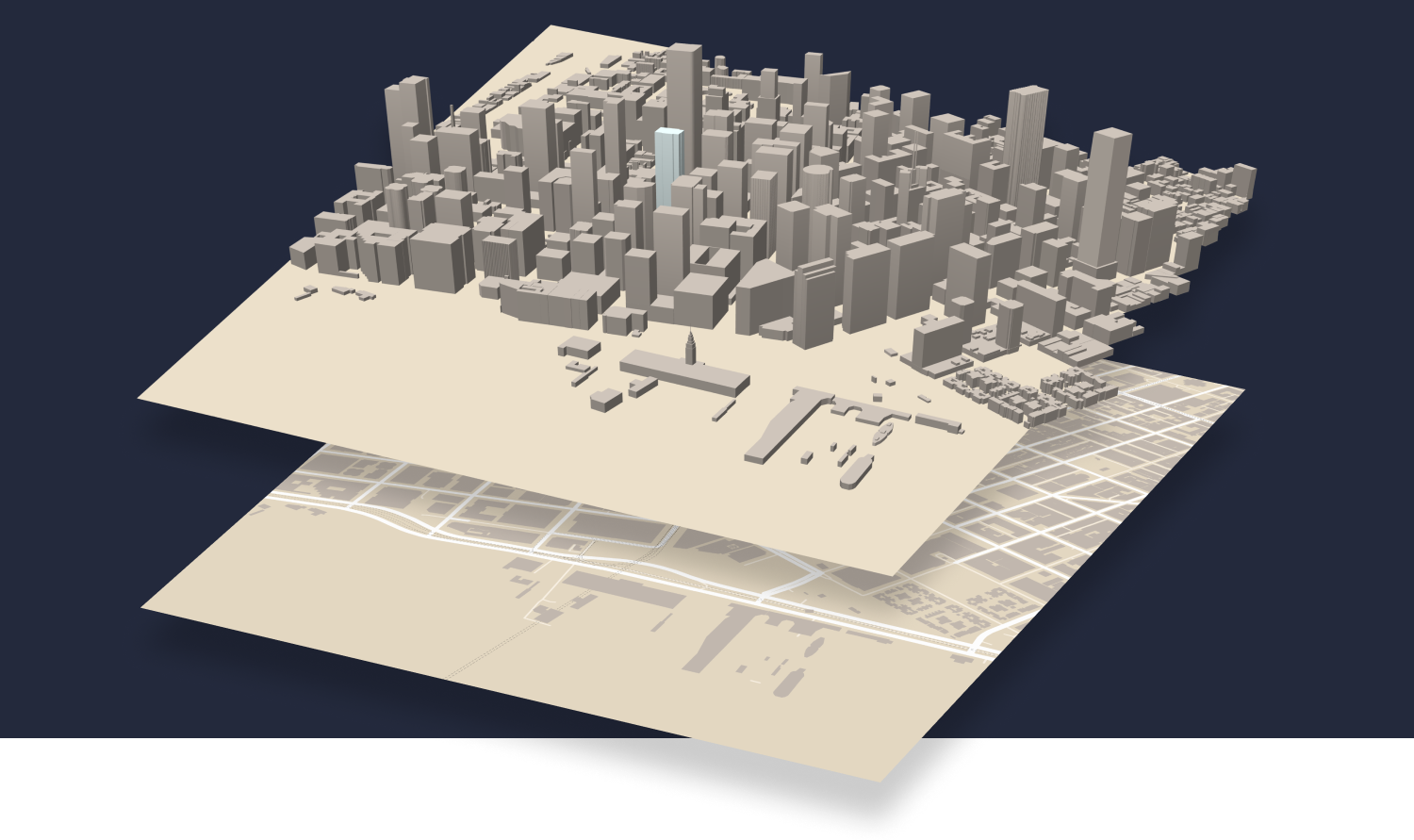Introduction
Data is everywhere. Sometimes it feels like we're drowning in it. But not all data is created equal.
In fact, we can view it as a spectrum. At one end, we have the open data, freely available for anyone to download. And on the other end we have the proprietary data, which is sold by the companies who collected the data. In between, is where ONEGEO data fits in and where you might land if you're looking for the best balance of cost and benefit.
Open Data is data that is freely available online for anyone to download and add to, such as OpenStreetMap data.
ONEGEO Data is open data that has been augmented by combining various data sources to create a richer, fuller picture than what is possible to obtain from a single source alone.
Proprietary Data is data that is available for purchase, such as satellite data that is owned by the satellite companies, who sell scenes from their datasets.
Your best choice will always depend on your specific requirements, so we're going to pick apart everything you need to consider when choosing what you really need.
So here goes, let's dive in.
Open data vs. custom data
So, let's look at the considerations and pros and cons of using open data, augmented open data, proprietary data and custom
collected data:

The potential cost of using 'free' data
While open data can be a great resource for businesses, there are potential hidden costs associated with using free open data. One of the biggest hidden costs is the time and effort required to process and clean the data. Open data is often raw and unstructured, which means it requires significant effort to make it usable.
Data may need to be downloaded as hundreds of individual tiles and then merged, the format may need to be converted before it can be imported into a standard GIS, and various sources may need to be combined to cover your whole project area. This can be particularly challenging for businesses that lack the necessary expertise or resources to handle large volumes of data.
Another potential cost is the risk of inaccuracies or errors in the data. Open data is often crowdsourced or sourced from multiple parties with varying quality and accuracy. This can lead to errors in analysis, which can have significant consequences for the user down the track.
Possible licensing issues must also be considered when using open data. While open data is intended to be free and publicly accessible, there may be restrictions on its use or redistribution. If you inadvertently violate these restrictions, you could face legal consequences.
Finally, there is the opportunity cost associated with using open data. While open data may be free, you may miss out on the insights and value that can be gained from richer data sources. So, while open data can be a valuable resource, you need to carefully consider the potential hidden costs associated with using it and weigh them against the benefits of other data sources.

Considerations when Choosing Data Sources
Consider the following factors when choosing your data sources:
Budget
Does your project budget allow for data to be purchased? If you have limited budget but still need confidence in the data you're getting, consider purchasing ONEGEO augmented open data, which is comprehensive, checked and cleaned, but at a lower cost than proprietary data.
Coverage
Does open data cover your area of interest? While open data is widely available in Europe and North America, open maps are largely blank in Africa and large parts of Asia, specifically China. Combining various open date sources can help overcome this issue, but you will need to carefully check availability for your project area before making a final call as the purchase of data may need to be factored into your budget.
Completion
Open data may not always be complete or up-to-date, and even proprietary data may not cover the exact area or timeframe you're interested in. Proprietary data will always give you the most complete coverage, but it might not be financially viable, so a second-best alternative might be your best bet. With ONEGEO augmented open data, you always get the newest data available.
Usability
Open data will likely require additional cleaning and processing to be usable. Combining, cleaning, checking, merging tiles, and bringing the data into a GIS-ready format will all fall to you when you opt for open data. So, consider the time and resources required to achieve this and whether opting for a paid data source may be the better option.
Quality
The quality of open data can vary widely, while proprietary data is generally of high quality. Consider the importance of data quality for your use case and whether you have the resources to check the quality of the data and metadata if you decide to go with open data.
Overall, the choice between the data sources depends on your business objectives, available resources, and the importance of data access, coverage, completion, usability, and quality.
At ONEGEO, we aim to provide you with the best of both worlds with augmented open data: keeping the costs down while giving you peace of mind about the quality, usability and completion of the data as well as providing it in a ready to use format and licensed to use commercially.
Risks of using open data
Aside from the considerations discussed above, there can also be certain risks associated with using open data. While they are certainly not always an issue or a real risk, it's important to be aware of the potential risks before making a decision.
Legal risks
There may be uncertainty around licensing and whether you're legally allowed to use open data for a specific purpose. This can lead to legal issues and potential lawsuits.
Incomplete Metadata Risks
Metadata is data about data and is crucial for understanding and quantifying uncertainties in a dataset. Incomplete or inaccurate metadata can make it difficult to understand the data fully, leading to incorrect conclusions and decisions.
Bias Risks
Open data may be selectively released by governments or organizations, potentially influencing decision-making processes or public perception on certain issues. Uncertainty around the intent behind the release of data can make it difficult to determine its usefulness in a given scenario and resulting outputs and decision making.
These issues can lead to wasted time and resources and potentially unreliable insights. So, it's important to understand and consider the potential risks early on in the project, before choosing a data source.

Using a Combination of Open and Custom Data
While each type of data has its own strengths and weaknesses, using them together can provide a more comprehensive view of the subject being studied. Open data can provide a broad foundation of information, while proprietary data can fill in gaps or provide more specific details.
Essentially, you may use open data in the early stages of a project to gain some high-level insights. Then, when you're ready to dive deeper, you'll know exactly what data you need and for what area.
The combination of different data sources can be lucrative, and there is no need to reinvent the wheel – if the data you need already exists, and is openly available, it makes sense to make use of it.

ONEGEO Data:
The Best of Both Worlds
We've been working in the open data space for a long time and believe that the 'sweet spot' on the continuum between open data and proprietary data is augmented open data.
Essentially, we've collated, combined, and cleaned worldwide building data from over 40 unique sources to now offer you reliable and comprehensive 3D building footprints and data in a GIS-ready format.
It's quality-checked and updated monthly, and you're legally licensed to use it commercially, so you can make data-driven decisions and impactful visualizations with confidence. It saves you the hassle and headache of free data and gives you a degree of customisation but is far less costly than proprietary data.
With ONEGEO augmented open data, you ...
- save time and resources that you would have to spend looking for the right data
- get data in a GIS-ready format or through API with no pre-processing required
- get monthly updates over time, so you're always working with the latest version
- get reliable data because it's quality-checked, so you don't need to worry about errors, outliers, or missing information
We're big fans of open data but we also totally respect the value of proprietary data and understand that there's no getting around it for some projects. So, if you need proprietary or custom collected data, talk to us about that and we'll be happy to make you an offer.
Conclusion
Ultimately, all data sources serve a purpose, and your choice of data source will depend on your project requirements and may even vary throughout the different stages of a project.
If you're ready to try out our augmented open data, get your $50 coupon here.

